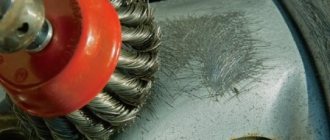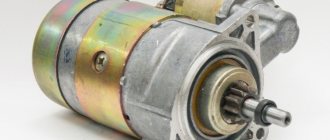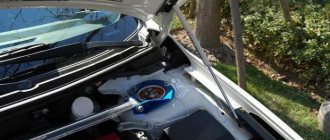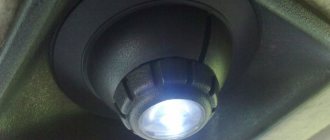Protect your car muffler from corrosion
To increase the service life of the exhaust pipe, car enthusiasts use two main methods:
- Drilling a hole in a pipe to allow condensate to drain out.
- Application of heat-resistant paint.
The first method allows condensation to escape, thereby preventing the accumulation of liquid and the formation of rust. Despite its effectiveness, not all motorists are ready for such radical interventions.
So, painting a car muffler with special paint to prevent it from rusting is often the only way to combat corrosion. This protects against rust and prevents accelerated aging of the metal from high temperatures. The best option is to paint the calipers with silver enamel: this is a reliable method, moreover, it is pleasant and affordable.
Muffler painting instructions
Preparation
Important! A heat gun cannot be used if it is made with a large amount of lead. This chemical element evaporates when heated, so it can be harmful to health.
Painting
If you have already decided on how to paint the car muffler so that it does not rust, you can start painting. This stage has its own difficulties. During the process of painting the muffler, smudges often form. They can worsen the performance characteristics of the unit and do not look aesthetically pleasing at all. To prevent the formation of sagging, you must adhere to a simple technology: – the enamel must be applied in thin layers, each time after complete drying; – the spray gun should be held at the same distance from the surface; – do not move the sprayer at an angle or in an arc; – the sprayed substance should capture not only the edges of the part, but also extend beyond its boundaries; – each strip must be applied evenly to the previous painted areas.
Pay attention to: How to choose paint by VIN number - search and determine the enamel code
Heat treatment
After coating, the surface needs additional heat treatment. The easiest way to do this is with a hair dryer. In order for a truly heat-resistant coating to form during the drying process, it is necessary to periodically pass hot air through the part in both directions. Some experts also advise pre-heating the outer part of the exhaust manifold. However, some motorists believe that this stage is not mandatory. According to them, the muffler heats up during the operation of the equipment, so it does not require additional calcination.
Is it allowed to paint the muffler on a car?
Whether to paint the exhaust pipe is up to you. The factory paint, which is mainly responsible for its presentable appearance, begins to lose its integrity soon after purchasing the car. In addition, scratches are possible already during installation, and welding work reduces the protective characteristics of the top layer.
Rusty car muffler
Although it is not covered with anything on the inside, when properly applied to protect the car muffler from corrosion on the outside, the paint still protects for some time, significantly extending the life of the part.
Preparing for the painting process
During preparatory work, special attention should be paid to cleaning the paint from old enamel. Neglecting advice may result in poor quality painting. It is especially important to completely remove all traces of corrosion and rust.
There are several options for removing such plaques:
- You can use a very stiff brush with high-quality wire bristles to clean the surface. If there is an area of pinpoint damage from destructive corrosion on the surface, it is worth treating it with epoxy putty;
- A conventional scraper can provide relatively good results. This device is used in the process of preparing various parts for the painting process. If you are processing a relief surface, you should use special shaped scrapers. To significantly speed up the process, it is recommended to use a special grinding machine;
- If it is necessary to remove a layer of old paint from the muffler, effective chemical removers can be used. They are ideal for cleaning surfaces from various water-borne paints, as well as organic compounds;
- An ordinary heat gun is perfect for high-quality cleaning of a car muffler, but it must be used very carefully. As soon as the paint swells and peels, it must be carefully removed.
This method is not suitable for parts that are made from materials that contain large amounts of lead, since during the heating process the latter can begin to evaporate quickly, which is very dangerous for the health of the person who is carrying out the painting process.
Selection of paint for a car muffler
Choose paint for the muffler based on the following basic parameters:
- Heat resistance (the higher the better: the exhaust pipe can heat up to 600 degrees, so its temperature range should be from -35 to 600 degrees Celsius).
- Anti-corrosion.
- Waterproof.
- Painting characteristics: structural uniformity, color saturation, drying speed.
It is best to buy silicone enamel or heat-resistant varnish.
Heat resistant
Silicone heat-resistant paints are popular among car enthusiasts because they are easy to use (applied in several layers and do not require a primer).
Painting a car muffler with a heat-resistant compound not only protects against rust, mechanical damage and chemicals, but also extends the life of the exhaust pipe, making it resistant to high temperatures.
Heat resistant paint for muffler
There is an important point that distinguishes heat-resistant paint for the muffler: in order for it to harden, the composition must be heated to 160–200 degrees. This can be done using a hair dryer or high temperature oven. The drying period for each layer is 15–20 minutes.
Fireproof
Painting a car muffler with fire-resistant powder paints, as a rule, takes place in an industrial environment. The composition, in comparison with silicone heat-resistant analogues, makes it possible to withstand higher temperatures. The main disadvantage is the difficulty of application.
Serebryanka
The best paint for a car muffler is silver. At service stations, it is most often made silver or black: these shades can withstand temperatures of up to 600 degrees in the short term, and up to 400 degrees in the long term. Other colors are less heat resistant.
How to quickly find damage
If the symptoms described above occur, it is important to accurately determine the original sources of the problem. To do this, it is not always necessary to seek professional help, spending financial resources.
Just by hand
When sounds and vibrations appear, you can determine the location of the leak yourself. In such cases, you can identify extraneous sounds purely by ear, and then carefully run your palm along the collector pipes without touching the hot metal. The surface of the palm will feel the movement of hot air.
In this way, it is possible to determine possible violations of the integrity of the exhaust structure at the joints or on the tubes themselves. Here it is important to carefully concentrate on your own feelings.
For dark spots
If the operation of the engine is accompanied by pronounced “clacking” sounds emanating from the pipes, resonator, or muffler itself, then under such circumstances we can say that the muffler is “cutting.” In other words, pipe bends, welds, and joints have lost their tightness.
Due to high temperatures and mechanical stress, holes appear here. Detecting them is quite simple, focusing on dark spots around the circumference.
Thus, damage can be found purely visually. The main thing is concentration.
Vacuum cleaner
A persistent smell of exhaust gases is a clear sign of exhaust manifold leaks. Identifying a crack here is not always easy, since the hole can be absolutely miniature in size. Due to the high heating temperatures, it is quite difficult to find the hole. You can simply burn your hands here.
The solution may be a regular vacuum cleaner. In addition, you will need tape, a small piece of rubber hose, and a funnel for liquid.
The check should be carried out according to the following algorithm:
- First you need to let the collector cool.
- Remove the air filters and bag from the vacuum cleaner, remove the nozzle, attach its hose directly to the exhaust pipe using tape.
- Make a stethoscope from a hose and funnel.
- Turn on the vacuum cleaner.
- By applying a stethoscope to different parts of the exhaust system, try to determine where exactly the air is being sucked in. In this case, the end of the hose must be rearranged as smoothly as possible, avoiding sudden movements and large gaps.
- After finding the hole, close it with your finger. When the noise stops, you can assume that this is the source of the problem. Otherwise, you need to continue searching.
Once breakdowns are detected, they can be sealed using sealant or welding.
Smoke generator
The generator is equipped with a pressure gauge, a smoke outlet hose, a nipple for connecting a pump or compressor, and a power supply with power control that can be connected to a car battery. In addition, you will need liquid cosmetic oil and a flashlight.
To diagnose, you need to perform the following steps:
- You need to connect a compressor to the device to inflate the tires.
- Insert the hose inside the exhaust pipe along with a cloth to seal it.
- Connect power to the battery terminals.
- Turn on the compressor.
- After this, you need to go down inside the inspection hole and use a flashlight to inspect the exhaust system.
- At the last stage, carefully inspect the cylinder head under the hood.
After diagnostics, seal the holes using sealant or welding. In some cases, certain parts may need to be replaced.
Therefore, an increase in exhaust noise is a serious sign of a problem. Damage can be detected using fairly simple methods. For a more accurate result, it is better to use special equipment.
We take a regular drill, a thin drill and drill a hole in the bottom of the muffler. As water accumulates, it will begin to come out through this small hole. A dry muffler is not as susceptible to corrosion, which means the metal product will last a little longer.
Most often, it is the inside of the part that rots. And to prevent this process, it is better to process it. The composition of the solution is as follows:
- graphite lubricant (1kg);
- solvent (1 l).
We will also need a container for preparing the solution, where we will mix the two ingredients. Mix the contents thoroughly and pour into the muffler. Just before pouring, close the second hole tightly.
Otherwise, the liquid will pour out through it, and the desired effect will not be achieved. Now you need to thoroughly shake the muffler so that the composition lies evenly on the metal surface. All that remains is to drain off the excess, dry it and you can put it on.
Here are two simple ways to help extend the “life” of the muffler.
Do you have any questions or something to add about the article? Write in the comments, perhaps this will greatly help readers in the future. Also subscribe to our channel in ZEN.
Requirements for the coloring composition
To paint the exhaust system of a car, choose a thermal paint that has the following characteristics:
- purpose: for painting the exhaust system and muffler (external side);
- heat-resistant (applied to a surface that is subject to constant or periodic heating);
- can be applied using a roller, brush, spray gun, or special electrostatic sprayer;
- the applied layer of paint hardens only under the influence of high temperatures;
- after hardening, the coating becomes resistant to water, corrosion, and high temperatures;
- additionally protects the system from fire;
- It has a long period of protection and decorative properties.











